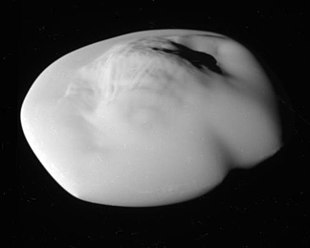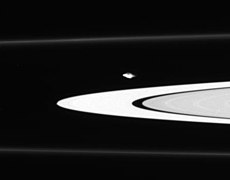Atlas (moon)
| Atlas | |
|---|---|

|
|
| Saturn's moon Atlas, captured from a distance of 11,000 km by the Cassini spacecraft on April 12, 2017 (84 meters per pixel) | |
| Provisional or systematic name | S / 1980 S 28 |
| Central body | Saturn |
| Properties of the orbit | |
| Major semi-axis | 137,670 ± 10 km |
| Periapsis | 137,505 km |
| Apoapsis | 137,835 km |
| eccentricity | 0.0012 |
| Orbit inclination | 0.003 ± 0.004 ° |
| Orbital time | 0.6016947883 d |
| Mean orbital velocity | 16.63 km / s |
| Physical Properties | |
| Albedo | 0.40 |
| Apparent brightness | 18.5 likes |
| Medium diameter | 30.6 ± 2.4 (46 × 38 × 19) km |
| Dimensions | 6.6 ± 0.6 · 10 15 kg |
| surface | ≈ 3,700 km 2 |
| Medium density | 0.44 ± 0.11 g / cm 3 |
| Sidereal rotation | 0.6016947883 days |
| Axis inclination | 0.0 ° |
| Acceleration of gravity on the surface | ≈ 0.0017 m / s 2 |
| Escape speed | ≈ 7.4 m / s |
| Surface temperature | ≈ −192 ° C / 81 K |
| discovery | |
| Explorer | |
| Date of discovery | November 12, 1980 |
| Remarks | Alleged shepherd moon of the A-ring |

|
|
| The positions of Saturn's inner moons in Saturn's ring system. From the inside out: Pan, Atlas, Prometheus, Pandora, Janus / Epimetheus, Mimas, Enceladus, Tethys, Dione and Rhea | |
Atlas (also Saturn XV ) is the fourth from the inside and one of the smaller of the 82 known moons of the planet Saturn . The moon orbits the planet in the Roche division outside the outer edge of the A-ring of Saturn's rings .
Discovery and naming
Atlas was discovered shortly before November 12, 1980 by the astronomer Richard John Terrile while evaluating images taken by the Voyager 1 space probe , which passed Saturn on that day.
The next day the discovery was announced by the International Astronomical Union (IAU); the moon was initially given the provisional designation S / 1980 S 28 . This high numbering resulted from the opinion that Saturn had 28 moons so far, which later turned out to be an exaggeration. Since many of the "newly discovered" moons were already known, the number was reduced to 17, making Atlas the 17th discovered and confirmed Saturn's moon . Since the lower numbered moons Prometheus and Pandora , discovered around the same time or shortly before, proved to be further away from Saturn, Atlas was given the Roman number XV .
Between 1980 and 2004 the moon could not be found again. It was only "rediscovered" in June 2004 in photos of the Cassini space probe .
On September 30, 1983, the moon was named after the titan Atlas , who in Greek mythology carries the world on his shoulders. Atlas was the son of Iapetus and the Oceanid Asia , the brother of Menoitius , Prometheus and Epimetheus and the father of the Hyades , Pleiades , Hesperides and (according to Homer) the nymph Calypso . Hyginus Mythographus , who wanted to emphasize the primeval character of the figure, made Atlas the son of Aether and Gaia .
Zeus punished Atlas after the titanic struggle for his loyalty to Kronos (Roman Saturn.) By him - instead of him like most other Titans in Tartarus to banish - condemned to (the earth) to be at Gaia's westernmost known point and his enormous strength to carry their husband Uranos (heaven) for all time . However, the goal was not so much to punish Atlas as Zeus wanted to prevent Uranus from breaking down on Earth because so much fighting had taken place there. Atlas' brothers Prometheus and Epimetheus as well as Kronos himself received a special punishment. As Atlas was later unfriendly to Perseus , the latter petrified him with the captured head of Medusa .
The name Atlas (Greek for "(he) carrier") was used for the Atlas Mountains (which Atlas itself is supposed to represent), for the star Atlas , the Atlas carrier rocket , the Atlas cervical vertebra , and for the Atlantic Ocean . However, the name does not stand for the atlas as a map series or for the legendary island of Atlantis .
Track properties
Orbit
Atlas orbits Saturn in a prograde , almost perfectly circular orbit at an average distance of 137,670 km (approx. 2,284 Saturn radii) from its center, i.e. 77,402 km above its cloud ceiling. The orbit eccentricity is 0.0012, the orbit is inclined 0.003 ° to the equator of Saturn , so it is almost exactly in the equatorial plane of the planet. Due to the low eccentricity, the distance to Saturn varies by only around 30 km.
The orbit of the next inner moon Daphnis is on average 1,165 km from Atlas' orbit, the distance of the orbit of the next outer moon Prometheus is on average 1,710 km.
Atlas orbits Saturn in 14 hours, 26 minutes and 26.4 seconds. This roughly corresponds to the orbital period of the Uranus moon Cupid . Atlas needs about 11 minutes longer to complete one cycle than its inner neighbor Daphnis. The moon runs around the planet in the 2,605 km wide Roche division named after Édouard Albert Roche , which separates the A-ring from the F-ring and is only 895 km away from the outer edge of the A-ring. It has long been assumed that Atlas acts as a shepherd's moon with its gravity on the inner A-ring; Instead, it is now known that the outer edge of the A-ring is in a 7: 6 orbit resonance with the larger, more distant moons Epimetheus and Janus .
The orbit of Atlas is significantly perturbed by the greater Prometheus (with whom it is in 54:53 orbital resonance) and to a lesser extent by Pandora , resulting in deviations in length of up to 600 km (~ 0.25 °) from the precessing Keplerbahn with a period of approx. 3 years. Since the orbits of Prometheus and Pandora are chaotic , so could Atlas be.
In 2004, a faint, thin ring of Saturn was discovered ("Ringlet"), which is located along the orbit of Atlas and was given the provisional name R / 2004 S 1 .
The moon orbits Saturn within a critical distance, the so-called Roche limit , which would cause a larger moon in this area to burst. It is likely that Atlas is only saved from this fate because of its small size or loose internal structure.
rotation
The rotation time is the same as the orbital time and thus Atlas (like the earth's moon ) shows a synchronous rotation , which also takes place within 14 hours, 26 minutes and 26.4 seconds. Its axis of rotation is almost exactly perpendicular to its plane .
Physical Properties
size
Atlas has a mean diameter of 30.6 km. In the recordings of the Cassini-Huygens - probe Atlas appears as an irregularly shaped elongated object having dimensions of 46 × 38 × 19 km, wherein the longitudinal axis is aligned with Saturn.
High-resolution images taken in June 2005 by the Cassini space probe show that Atlas is not round, but much wider at the equator than at the poles. This gives it the appearance of a flying saucer . It is believed that the particularly pronounced shape was created by Atlas collecting material from the extremely thin ring R / 2004 S 1 at its equatorial region . In fact, the size of the equatorial bulge is comparable to the expected size of the Atlas Roche lobe . This would mean that no more particles could collect at the equator without being pushed back into space by the centrifugal force , which overcomes the weak gravity of Atlas.
The total area of Atlas is an estimated 3,700 km², which roughly corresponds to the land area of Burgenland .
internal structure
The mean density of Atlas, at 0.44 g / cm³, is far lower than that of Earth and even considerably lower than the density of Saturn; it is so low that Atlas would float on water. This indicates that the moon is predominantly composed of water ice .
The fact that Atlas Saturn orbits within the Roche limit indicates that it either has a very solid internal structure or that it belongs to the so-called rubble piles , which have cavities inside due to the comparatively weak gravity. Because of the extremely low mean density, the latter hypothesis is more likely.
surface
The surface of the moon shows hardly any impact craters , which indicates a relatively young age. Atlas has a relatively high albedo of around 0.4, which means that it has a bright surface that reflects 40% of the incident sunlight . On its surface, the acceleration due to gravity is 0.0017 m / s², which corresponds to about 0.2 ‰ of that on earth. The mean surface temperature of Atlas is estimated to be approximately −192 ° C (81 K ).
exploration
Due to the small size and apparent brightness of 18.1 m (which is 1: 20900000 that of the central planet) as well as the close proximity to Saturn and the fact that it is outshone by it, Atlas cannot be seen with earth-based telescopes; for this reason it is not surprising that Atlas could not be found for 24 years.
Since then, Atlas has been visited by three space probes , namely the flyby probes Voyager 1 on November 12, 1980 and Voyager 2 on August 25, 1981, and the Saturn orbiter Cassini , which has been orbiting Saturn since July 2004. Atlas has been targeted by Cassini several times, so its orbital parameters are now fairly well known. Cassini's next flyby occurred during its 46th orbit around Saturn on June 12, 2007, when the Atlas probe passed at a distance of 40,000 km. It was possible to take some pictures with good resolution.
gallery
Atlas, 40,000 km from Cassini on June 12, 2007 in the direction of the South Pole
Atlas near the F-Ring on May 9, 2005
Web links
- IAUC 3539: 1980 S 28 November 13, 1980 (discovery)
- IAUC 3872: Satellites of Jupiter and Saturn September 30, 1983 (designation)
- The peculiar shapes of Saturn's small inner moons (English)
Individual evidence
- ↑ Paul Rincon: Saturn overtakes Jupiter as planet with most moons. BBC , October 7, 2019, accessed March 20, 2020 .
- ^ The Orbits of Saturn's small satellites. Retrieved February 15, 2011 .
- ↑ Spectrogram . In: Spectrum of Science , 2/08
- ↑ Gravity acceleration g ~ 9.81 m / s ^ 2, therefore the surface acceleration on Atlas corresponds to 0.0017 / 9.81 ~ 1.73 * 10 ^ (- 4) ~ 2 * 10 ^ (- 4) = 0.2 per thousand * g
| further inside | Saturn moons | further outside |
| Daphnis |
Semi- major axis (km) Atlas 137.700 |
Prometheus |






